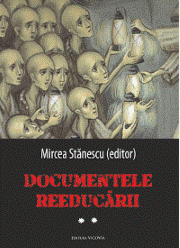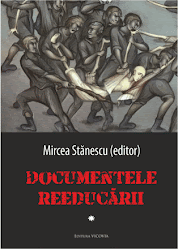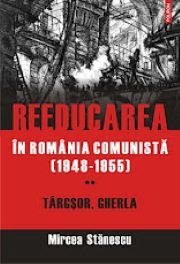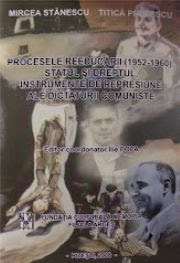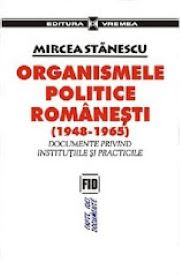THE MEDIA VS. HISTORICAL ACCURACY: HOW ROMANIA’S CURRENT COMMUNIST TRIALS ARE BEING MISREPRESENTED
(with
Elena Dragomir)
Balkanalysis.com
Editor’s note: since the fall of 2014, Romania has received new foreign media
attention over a trial that has rekindled interest in the country’s Communist
past. However, in so doing, the media has also tended to exaggerate and
misrepresent the current proceedings and their significance- and thus has
failed to note how Romanian authorities in recent years have actually displayed
a general disinterest and incompetence in regards to investigating and
prosecuting the crimes of the former communist governments.
The following analysis, written by two leading researchers
in the field of Cold-War Romanian affairs, sheds new light on the current
trial, in the context of its deeper historical context, and its implications
for current politics and future interest in addressing communist-era crimes
against the Romanian people.
Political
Persecutions in Communist Romania
The
communist regime in Romania was established between 1944 and 1948, in the
aftermath of the Second World War, under the new circumstances of Romania’s
placement within the Soviet sphere of influence. The newly established
communist-led regime rapidly initiated merciless repression campaigns,
targeting the current or former so-called enemies of the people – former
leaders or members of Romania’s historical political parties, former officers
in the Romanian army, ethnic or religious minorities, industrialists (seen as
former exploiters of the poor), so-called collaborators of the previous
political regime, former ministers, diplomats, academics, economists,
historians, journalists and so on.
The cumulative result was that by end of 1950s, hundreds of
thousands of people had been arrested, deported or incarcerated for political
reasons, without any concern for respect of the most elementary human rights.
A police state, the communist-led Romania used a range of
security forces – secret police, militia/regular police, civilian informants
and spies to enforce its authority. The security forces arrested, detained,
tortured and even murdered “suspects” for no reason, often without having a
warrant or a court order, and often without informing families about what
happened to their disappeared loved ones. Assassination, kidnapping and torture
were instrumentally used by the secret police to prevent, investigate or punish
(real or imagined) opposition. Opponents were incarcerated in prisons,
concentration camps and (later) psychiatric hospitals, with or without a court
order.
Political
Prisons and Labor Camps in Communist Romania: Statistical Data
According
to one scholarly estimate, between 1948 and 1964, Romania operated over 130
political prisons and camps; other estimates have it at over 200. These camps
held over 600,000 political detainees. Adding to this the deportees and the
political detainees of the period 1964-1989, the number reached 780,000 persons
(for the period 1948-1989).
According to other scholarly estimates, during the
cumulative period (1948-1989), over 2,000,000 people were victims of the
Romanian Communist system, detained for political reasons in prisons, labor
camps, deportation centers or psychiatric facilities (for more information, see
Comisia Prezidenţială pentru Analiza Dictaturii Comuniste în Romania, Raport
final, Bucureşti, 2006, 160-161[1]).
Among the most notorious and infamous Romanian political
prisons and labor camps were those in Suceava, Jilava, Piteşti, Gherla, Sighet,
Aiud, Târgu Ocna, Poarta Albă, Peninsula, Periprava, Cernavodă, Mislea and
Râmnicu Sărat. The living and working conditions in such labor camps and
prisons were very harsh. Working quotas were continuously increased and food
rations cut, while medical care and supplies were virtually non-existent.
Food shortages, a lack of medical care, cold weather and
physical abuse of prisoners all contributed to high mortality rates. Documents
from the archive of the communist Ministry of Interior attests 3,847 deaths in
detention for the period between 1945 and 1965, of which 203 died during
interrogation, 2,851 during detention, 137 were executed following a death
sentence, and 656 while in forced labor camps[2].
However, these numbers are just a small fraction of the true
number of fatalities; it is impossible to estimate how many political detainees
actually died, because the officials at these facilities usually did not keep
records. They also simply erased a number of prisoner deaths from their
official records.
The
‘Piteşti Experiment’ and Vișinescu’s ‘Prison of Silence’
One
of the most notorious and infamous brainwashing experiments in Eastern Europe’s
history took place in Romania, in the political prison of Piteşti, a small
town, about 120km northwest of Bucharest. This prison is infamous in Romania
still for the so-called the ‘Piteşti experiment’ or Piteşti phenomenon,
conducted there between 1949 and 1952.
The experiment aimed to ‘reeducate’ the (real or imagined)
opponents of the regime. It involved psychological and physical torture of
prisoners, and the submission of them to humiliating, degrading and
dehumanizing acts. Tens of people died in this ‘experiment’, but its aim was
not to kill the people, but to ‘reeducate’ them.
Some of those who were thus ‘reeducated’ later became
torturers themselves. Of those who survived Piteşti, many either took their own
lives or ended up in mental institutions (for more information, see Mircea
Stănescu, Reeducarea în România comunistă, Polirom, Iaşi, Vol. I: 2010,
Vol. II: 2010, Vol. III: 2012).
The Râmnicu Sărat prison was another infamous place in the
Romanian political detention system[3]. This prison, which is now being
remembered with the media-cited trial of its former commander, Alexandru
Vișinescu, remains in the collective memory as the ‘prison of silence.’ Prison
rules stated that between 5am and 10pm, the prisoners (who were kept in
solitary confinement) were forbidden to lie in bed, and were instead forced to
stand or sit without moving, facing the cell door. They were forbidden to make
any noise, to speak with other prisoners or with guards- essentially, they were
not allowed to speak unless spoken to. They were even not allowed to look out
the window.
Any ‘mistake’ or ‘misbehavior’ would result in severe
punishment, often, under the direct supervision of the prison’s commander,
Alexandru Vișinescu. These unlucky prisoners might be beaten, tortured, kept in
severe cold, and deprived of medical care or food.
Alexandru
Vișinescu: Short Biography of a Notorious Prison Commander
Alexandru
Vișinescu[4] was born into a very poor village family in 1925. This background
meant that he was of what the Romanian Communist Party deemed ‘healthy social
origins.’ In 1948, he completed his mandatory military service, by working in
the Securitate (the secret police agency) and Militia (the civilian police)
forces.
Later, Vișinescu was hired full-time by the Securitate, and
in January, February and March 1950 he was trained to become a political
officer for work in prisons and labor camps. During this training, Vișinescu
became familiar with the state’s Piteşti-type ‘reeducation’ methods. After
graduating, he was appointed political officer at the Jilava prison, where he
served between 1950 and 1953, and where he carried aut Pitești-type tortures
against detainees[5].
Jilava was a multi-faceted detention facility. It served as
a prison of transit, as a center where the death sentences of political
prisoners were carried out, as a place where political sentences were served,
as a school for prison guards, as a place of torture and of ‘reeducation’,
where political detainees were forced to expose (demascare, in Romanian)
the ‘misdeeds’ of themselves and others.
In 1953 and 1954, Alexandru Vișinescu was sent to work as
political officer at the women’s prison in Mislea. There, he forced the
prisoners to do things like get naked and jump like frogs, a torture that had
origins in Piteşti re-education-methods, and that aimed to physically and
especially psychologically crush the detainees. Between 1954 and 1956,
Vișinescu was a political officer at the Râmnicu Sărat prison and later
(1956-1963) commander of the same facility.
Scholars consider that, at the Râmnicu Sărat prison,
Vișinescu employed one of the worst detention regimes known in Communist
Romania. In the late 1950s and early 1960s, the Râmnicu Sărat prison was the
main extermination center in Romania, replacing in this sense the Sighet prison
that had had the same sinister role 10 years earlier. Detainees at the Râmnicu
Sărat prison were forced to sit immobile for 17 hours per day, keeping their
hands on their knees and looking straight at the light bulb above their cell
door. This was a variation of the ‘unmasking position’ used in the Piteşti
‘reeducation’.
Vişinescu retired in 1978, during the time of dictator
Nicolae Ceaușescu. Thereafter he would receive the substantial monthly pension
to which former Militia colonels were entitled. In 2013, the Institute for the
Inverstigation of Communist Crimes and the Memory of Romanian Exile
(IICCMER)[6] prepared an indictment against Vişinescu. Initially, he was
accused of genocide, because “genocide” was the only crime for which
prescription did not apply. In Romanian Law, a lawsuit must start within a
legally determined period of time. If the lawsuit is presented after that time,
an institution called prescription applies, which prevent authorities from
filing the case. According to the Penal Code in force at the time “genocide”
was the only crime for which prescription did not apply. Under the new Penal
Code, however, which entered into force on 1 February 2014, Vişinescu was
accused of crimes against humanity.
The Vişinescu Trial and Media Misunderstandings about
Possible Future Prosecutions
Foreign mass media (such as The Guardian in September
2014[7]) has followed the Alexandru Vişinescu trial. The English newspaper
claimed that a total of 35 former officers associated with communist-era
Romanian prisons and labor camps’ are about to be prosecuted for the
mistreatment, torture and murder of political prisoners.
In reality, however, such a list
does not exist (and never has). What has actually happened regarding such
matters is as follows.
Legal Cases Brought against Former Commanders and Guards
(2004-2013) by Victims’ Associations and Individuals
Since 2004, several associations of victims of the communist
regime, as well as some individuals, have filed criminal complaints concerning
different political crimes allegedly committed during the communist era.
The Military Prosecutor’s Office,
which is attached to the Military Court in Bucharest, grouped all these
complaints into File no. 35. It is now commonly referred to as the ‘communism
lawsuit.’ In May 2007, IICCMER filed a criminal complaint against 210 former
officers from different communist prisons and labor camps. Besides the names of
the 210 political offices, the complaint also contained victims’ testimonials.
(This was documented by Raluca Grosescu and Raluca Ursachi in Justiția
penală de tranziție. De la Nürnberg la postcomunismul românesc, Iași,
București, Polirom, 2009, 194-196).
Despite these actions, none of the
former commanders or guards were ever investigated, charged with particular
offences or prosecuted. In 2013, out of the previous 210 officers, IICCMER
considered the possibility of re-filing complaints against 35 potential
offenders, but eventually it filed criminal complaints only against five people:
Alexandru Vişinescu, Ion Ficior (former commander of the Poarta Albă and
Periprava camps), Iuliu Sebestyen (former deputy commander of the Gherla
prison, but deceased since October 2013), Florian Cormoș (former commander of
the Cernavodă camp) and Constantin Istrate (former deputy commander of the
Gherla prison). In fact, in 2013, IICCMER re-filed the 2007 complaints.
Vișinescu’s lawsuit is currently
underway at the Appeals Court in Bucharest, and there have been over ten
hearings so far, including those from 22 September, 24 September, 22 October, 5
November or 17 December. In this lawsuit, only victims or relatives of the
victims were admitted as civil plaintiffs.
However, it is worth mentioned that
Valentin Cristea, the only survivor of the Râmnicu Sărat prison, and the two
sisters of Corneliu Coposu – former leader of the National Peasants’ Party,
incarcerated for political reasons in the Râmnicu Sărat prison between 1954 and
1962, and deceased since 1995, never became civil parties in this lawsuit, for
reasons that are still unclear.
Different NGOs representing the
interests of the former political detainees could not testify against Vișinescu,
on the grounds that the penal legislation does not stipulate the intervention
into the lawsuit of persons or organizations that are not parties in the legal
action. In fact, the only civil parties admitted in this lawsuit were Anca
Cernea, the daughter of Emil Bărbuș, former political detainee at the Râmnicu
Sărat prison, and Nicoleta Eremia, the wife of another political detainee, Ion
Eremia.
Other Current Legal Developments: the Eremia Case
In the debate regarding Romania’s capability to come to
terms with its communist past, the case of Nicoleta Eremia is rather
interesting[8]. Ion Eremia was detained at Râmnicu Sărat prison between 1958
and 1964, and his widow, Nicoleta Eremia, is now asking for moral and material
compensation of 100,000 euros for the sufferings that the communist regime
caused to her husband and to herself personally during the time they were
married (1971-1989). Yet this case is somewhat more complicated than most
others.
Ion Eremia was a member of the
interwar illegal Communist Party of Romania, a Major-General in the postwar
Romanian Army and the commander of the Political Military Academy “I.V. Stalin”
from Bucharest. In 1955, in the context of de-Stalinization, he was purged
under the accusation that he had been co-plotting to remove the communist
leader Gheorghe Gheorghiu-Dej from office. He was arrested three years later in
1958 and incarcerated at the Râmnicu Sărat prison.
In other words, Eremia was among
those actively involved in Romania’s communization and Sovietization in the
late 1940s and early 1950s, and his purging occurred in the context of the late
1950s domestic struggle for political power between different echelons of the
Romanian Communist Party. Thus, it is at very least strange that in this
lawsuit, Ion Eremia’s widow was, for nine hearings, the only legal
representative of the political victims of the communist regime. In the
meantime, the 88 year-old Alexandru Vişinescu continues to use any possible
legal trick to try to slow down the proceedings against him.
Political Implications of Recent Attempts to Prosecute
former Communist Commanders and Guards
IICCMER is a governmental agency. Its indictment against
Vişinescu was made in 2013. However, in May 2012, Romania’s government had been
formed by the Social Liberal Union (USL). This union had itself been formed by
the Social Democratic Party (PSD), National Liberal Party (PNL) and
Conservative Party (PC). During that same year, the Victor Ponta cabinet
appointed a new candidate as president of the IICCMER, the young and ambitious
PNL member Andrei Muraru. When the USL broke up in 2014, Andrei Muraru
resigned, and was replaced by Radu Preda, Professor of Orthodox Theology at the
Babes-Bolyai University in Cluj-Napoca. Preda was commonly considered as being
close to the PSD.
In spring 2014, Muraru ran
(unsuccessfully) as a PNL candidate in the European parliamentary elections;
his campaign slogan was ‘Andrei’s country- no communists.’ This slogan was
meant to refer directly to his political ambitions with his former IICCMER
office. It is also worth mentioning that throughout 2013 and 2014, Muraru was
very present in the national media[9], in connection to the Vişinescu case, and
one can only suspect that the ambitious PNL member used this lawsuit to try to
gain voter support.
Interestingly though, the file
generally designated as the “communism lawsuit” has been left untouched,
gathering dust in the archive of the Military Prosecutor’s Office. One may
justifiably raise the question as to why there is only one such case in trial
phase (the Vişinescu case).
Further, the criminal complaint that
the IICCMER filed against Vişinescu in 2013 was amateurishly elaborated, which
suggests that it was primarily designed as a propagandistic tool to be used to
support some hidden political agenda. So far, the most important factor that
has influenced the trial has been this amateurish quality in which the IICCMER
elaborated the 2013 criminal complaint against Alexandru Vişinescu.
In the complaint, the IICCMER
charged Vişinescu only with the crimes he committed in the Râmnicu Sărat prison, but made no reference to the
crimes he committed at the Jilava and Mislea prisons. Were these omissions due
to genuine incompetence, or perhaps to a political agenda? Probably a little of
both.
Conclusion: No Signs of a ‘Romanian Nuremberg’
As far as the ‘Romanian Nuremberg’[10] associations being
made in the international media go, there is thus no such thing. This
exaggeration once again may suggest that the IICCMER has a hidden agenda,
trying to win foreign sympathy for the current government. Or, as the
comparison was initially made by Radu Preda, president of the IICCMER, it may
simply be that the current president of the IICCMER and his team of researchers
are simply not very competent in their research duties.
In fact, the Romanian court for
communist crimes cannot be compared to a historic event like Nuremberg. For
one, it is a national court, not an international one, ruling on the crimes of
a single person. Further, the evidence is very scarce. Finally, the case is
being amateurishly presented by a government commission lacking expertise. Thus
the trial will probably lead to no conviction.
Assuming that 88 year-old Alexandru
Vişinescu lives to see out his trial, we may thus expect one of several
possible outcomes. Given the poor evidence presented during the trial,
Vişinescu will not be convicted or, if he is convicted, the sentence will be
light, or even commuted in consideration of his advanced age.
In any case, whatever the verdict
the court reaches will not amount to sufficient legal or moral justice, given
the extent of his crimes. Further, given the current legal obstructions and
general lack of traction in regards to cases against the other former
commanders and prison guards cited above, it is clear that the wider crimes of
the former communist regime on a systematic level will never be legally
acknowledged.
And so, far from a ‘Romanian
Nuremberg,’ the apparent lack of interest or competence in handling these cases
indicate that the residual wounds associated with the country’s communist past
will remain unhealed.
NOTES
[6] Cf. http://www.iiccr.ro/en/.
[9] Ibidem.
Bucharest, 11th January 2015
Published on Balkananalysis.com. See: http://www.balkanalysis.com/romania/2015/01/11/the-media-vs-historical-accuracy-how-romanias-current-communist-trials-are-being-misrepresented/.
Abonați-vă la:
Postări (Atom)





